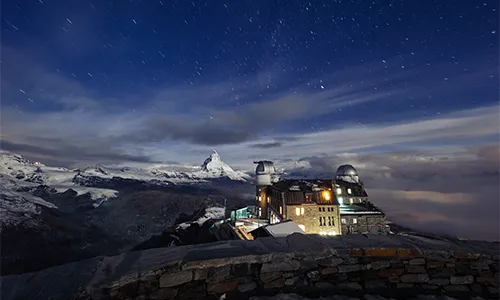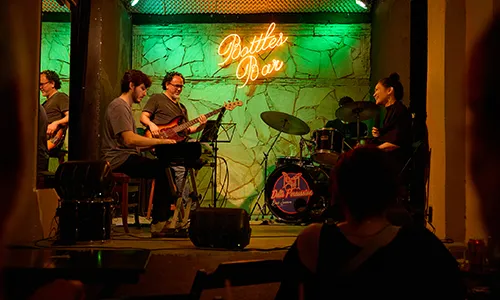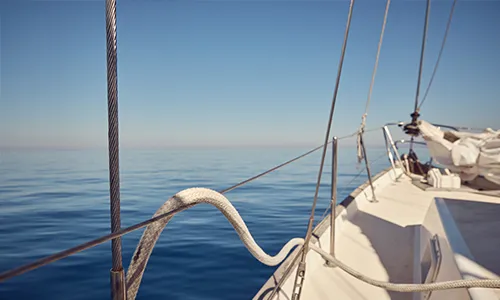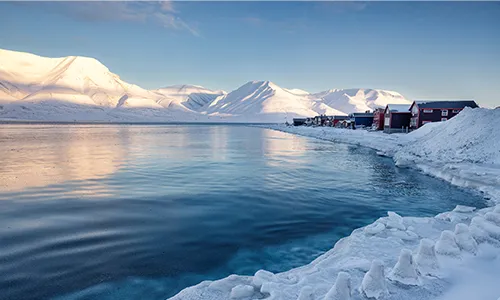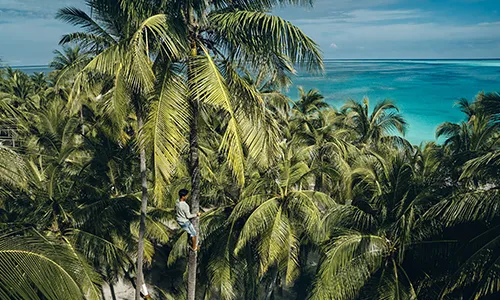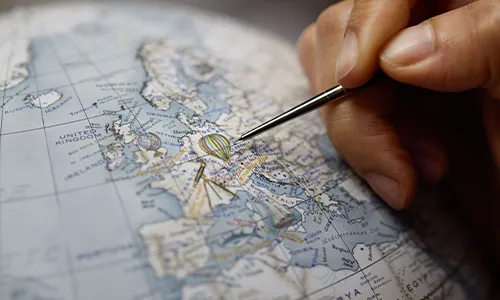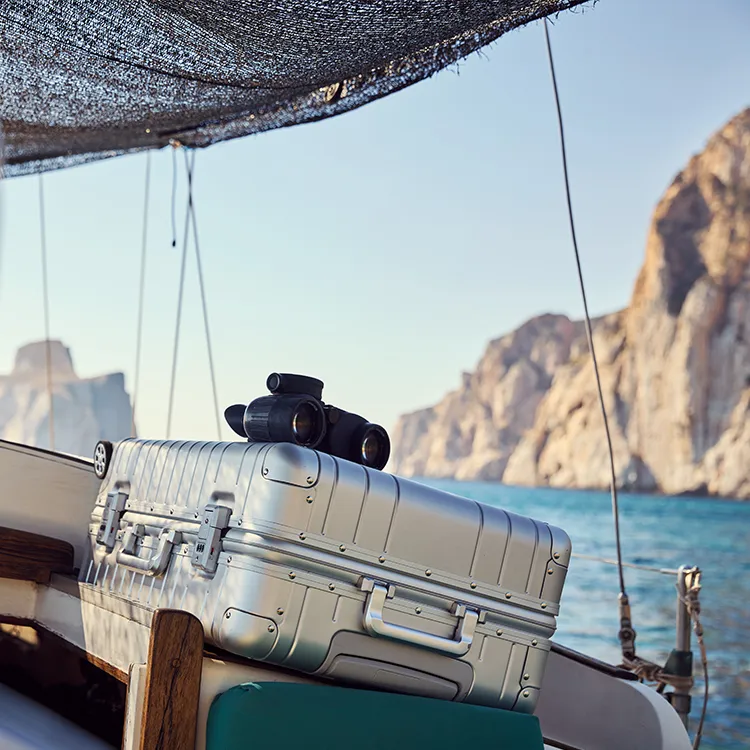Isola di San Pietro:
all roads lead to the sea

Departing Sardinia by ferry, you can see San Pietro Island in the distance: a flat, beach-fringed islet floating in the sea with a gentle elevation in the middle. From Portoscuso, the ferry steams south for four nautical miles, across waters shimmering with sand and seagrass. Soon, ahead of the bow, the island will gradually emerge.
The entrance to the harbour comes into view with its two mole lighthouses, the quay on the Corso Battellieri. Carloforte, the island’s only town, spreads out beyond it. A collection of brightly coloured houses like a watercolour casually painted onto the shore. Palm trees, cafés, pink facades, walls painted lime green.
With a gurgle of wake, the ferry berths. Cars roll onto the quay, passengers walk down the gangway like awestruck extras entering an old theatre. Insular Italy, Carloforte is the stage, and the piece being performed seems to hail from a forgotten century. With a gurgle of wake, the ferry berths. Cars roll onto the quay, passengers walk down the gangway like awestruck extras entering an old theatre. Insular Italy, Carloforte is the stage, and the piece being performed seems to hail from a forgotten century.

Laundry flaps on balconies, waiters bring tagliere, charcuterie boards, to the tables below. A blinking diver sign calls attention to Tutti Pesca Mare, a small shop where Massimo sells harpoons, fishing rods and neoprene wetsuits. Around the corner, at the Roma bar, elderly locals sit around the cast-iron tables beneath three jacarandas, chatting and smiling knowingly.
The tiny island basks in the southern Mediterranean sun like a relic from another time. Indigo-coloured water on all sides; steep cliffs in the north; La Caletta cove in the south. Down in the village, photos of gozzi, old lateen-rigged fishing boats, hang on pub walls. Bottles of Campari, grappa and liqueur line the shelves. The publicans behind the bars are jolly and unshaven. This island is their home. An island that nothing and no one will ever persuade them to leave.


A maritime idyll indeed, but little do visitors realize what a fascinating place they’re about to discover. The history of San Pietro Island begins with Tunisian coral fishers from Tabarka. In the mid-18th century, Genoese seafarers from the town of Pegli, originally from Tunisia, settled on what was then an almost uninhabited island. People speak their own dialect here too: old Tabarchino.
Everyone here knows San Pietro’s history: the language, the seagoing tradition, the way of life. This isn’t Sardinia, it’s not even really Italy. It’s an island off an island – proud and staunch. A cradle of seafaring, a cactus-covered rock inhabited by boatmen and navigators.

And something else: it’s where the tonno rosso swim, large bluefin tuna that migrate from North Africa to the Ligurian Sea each spring in giant swarms, which pass right by the island. During the annual tonnara, the Carlofortinians catch them as they did a thousand years ago. With a system of nets and pure muscle. You could say that tiny Carloforte is the tuna capital of the world. A place entirely dedicated to the sea where maritime traditions shape collective memory. On good days, even the air tastes like salt water.
No, this is no ordinary harbour town. The island is more like a ship. Live here for long enough and you could begin to imagine you’re on the high seas. Walking through the old alleys, you see fish everywhere.
The tonno rosso are painted on steps, they swim on walls and beneath ceilings, are whittled from wood and made out of cork from decommissioned buoys. Planks from sunken fishing boats are nailed to pub walls. The paving stones leading to San Carlo Borromeo church are engraved with images of fish. And the colourful little dresses in the boutiques hang on spars from disused rowing boats.


Up in the north, near La Punta, Antonello Rosso leans against the bonnet of his 4x4, looking out to sea. Fishing nets lie spread out behind the rocks by the old tuna factory; beyond it the unbroken expanse of the Sardinian Sea stretches all the way to Tunisia in the south and across to the Balearics, 240 nautical miles away. Antonello Rosso is wearing shorts and sandals and a white t-shirt. Methodically, he rolls a cigarette.
‘See the swell coming in from the west?’, he asks. ‘See the waves breaking against the cliffs?’ Rosso fumbles for his lighter. ‘You know what? I love this island!’
The words sound like they’re out of a glossy brochure, but they’re spoken from the heart. They spring from the soul of a born Carlofortinian, a man with the island in his blood.
This is true for everyone born and raised on San Pietro. The marinai in the harbour, the fishers, the ferrymen. Even the island’s cooks are connected to the sea, far and above proclaiming their love for it and featuring delicious seafood on the menu. Most of them are fishers themselves. They sail, dive, swim or take a boat out to Isola del Corno to spearfish.

Der beste Beweis dafür ist Antonello Pomata, der bekannteste Koch der Insel. Früher segelte er selbst, verbrachte jeden zweiten Tag auf dem Wasser. Er steuerte die alten Lateinerboote, nahm an Regatten teil, querte sogar den Atlantik. Zwischendurch allerdings verließ der junge Antonello die Insel und reiste mit Anfang 20 durch die weite Welt der Hotellerie und Gastronomie. New York, London, Mailand, Paris. Er arbeitete als Barmann, Sommelier und Maître d’Hotel, lernte bei dem britischen Starkoch Marco Pierre White. Doch selbstverständlich kehrte er zurück auf seine Insel! Was ist das Leben ohne das bunte Carloforte? La Casa. Die Heimat.
Heute führt Antonello Pomata sein eigenes Restaurant unten am Hafen. Das berühmte Da Nicolo. Vor dem Eingang hängen Michelin-Auszeichnungen, diverse Plaketten und Ehrungen aus der Welt der gehobenen Gastronomie. Im Sommer brummt das Lokal. Italienische Fußballstars kommen hierher, Politiker, Modeleute, Reeder.
Der beste Beweis dafür ist Antonello Pomata, der bekannteste Koch der Insel. Früher segelte er selbst, verbrachte jeden zweiten Tag auf dem Wasser. Er steuerte die alten Lateinerboote, nahm an Regatten teil, querte sogar den Atlantik. Zwischendurch allerdings verließ der junge Antonello die Insel und reiste mit Anfang 20 durch die weite Welt der Hotellerie und Gastronomie. New York, London, Mailand, Paris. Er arbeitete als Barmann, Sommelier und Maître d’Hotel, lernte bei dem britischen Starkoch Marco Pierre White. Doch selbstverständlich kehrte er zurück auf seine Insel! Was ist das Leben ohne das bunte Carloforte? La Casa. Die Heimat.
Heute führt Antonello Pomata sein eigenes Restaurant unten am Hafen. Das berühmte Da Nicolo. Vor dem Eingang hängen Michelin-Auszeichnungen, diverse Plaketten und Ehrungen aus der Welt der gehobenen Gastronomie. Im Sommer brummt das Lokal. Italienische Fußballstars kommen hierher, Politiker, Modeleute, Reeder.


Ob auch die Geschichte mit Johnny Depp stimmt? „Ja, ja, die stimmt“, sagt Pomata. Und die Geschichte mit Tom Cruise, die stimme auch. Cruise kam einmal mit seiner Jacht mitten im Hochsommer nach San Pietro. Er wollte ins Da Nicolo, aber er hatte nicht reserviert. Das Lokal war voll. An diesem Abend, am nächsten, die ganze Woche. Was sollten sie machen?
Scusi. Geht nicht. Echt nicht.
„Inselkoch schickt Hollywoodstar weg“, posaunte prompt die Presse. Was ein bisschen aufgebauscht war. „Cruise war nett, ein ganz normaler Typ“, sagt Pomata. „Wir haben das Essen dann porta via gemacht, Take-away.“ Cruise und seine Entourage gingen mit Plastiktüten von der Insel.

Antonello Pomata spaziert am Abend noch durch sein Restaurant, parliert mit den Gästen. Darunter sind vor allem ganz normale Besucher. Menschen, die das Meer lieben, gutes Essen und den Thunfisch, der vor der Haustür schwimmt.
Ein warmer Wind streicht durch die Palmen an der Promenade. In der Bar nebenan sitzen die Marinai, die Flaneure des Sommers. Unter den Tischen wackeln die Schlappen, Musik kommt aus den Lautsprechern. Die Kellner aber rauchen schon mal eine. Sie räumen zusammen, stapeln die Stühle und machen langsam Feierabend.
Auch das ist so, auf dieser Insel vor der Insel. Die Isola di San Pietro liegt zum Glück weit genug weg vom Rest der Welt. Ein paar unbezahlbare Seemeilen, ein paar Jahrhunderte mit eigener Geschichte. Es wird darum selten spät auf diesem Felsen in der See. Party sollen ruhig die anderen machen. Morgen früh wartet wieder das Meer.
Nicht die Arbeit, sondern das Leben.

Antonello Pomata spaziert am Abend noch durch sein Restaurant, parliert mit den Gästen. Darunter sind vor allem ganz normale Besucher. Menschen, die das Meer lieben, gutes Essen und den Thunfisch, der vor der Haustür schwimmt.
Ein warmer Wind streicht durch die Palmen an der Promenade. In der Bar nebenan sitzen die Marinai, die Flaneure des Sommers. Unter den Tischen wackeln die Schlappen, Musik kommt aus den Lautsprechern. Die Kellner aber rauchen schon mal eine. Sie räumen zusammen, stapeln die Stühle und machen langsam Feierabend.
Auch das ist so, auf dieser Insel vor der Insel. Die Isola di San Pietro liegt zum Glück weit genug weg vom Rest der Welt. Ein paar unbezahlbare Seemeilen, ein paar Jahrhunderte mit eigener Geschichte. Es wird darum selten spät auf diesem Felsen in der See. Party sollen ruhig die anderen machen. Morgen früh wartet wieder das Meer.
Nicht die Arbeit, sondern das Leben.


Autor


Fotograf


Aluminium Collection
Reisebegleiter

Entdecken Sie die Welt mit uns











